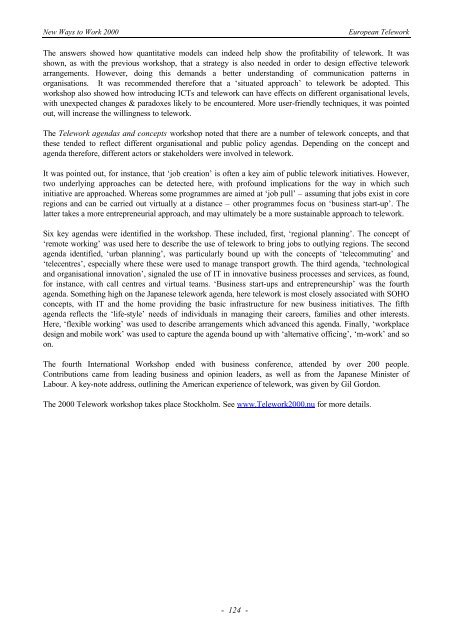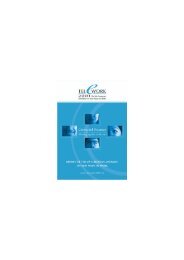New Ways to Work <strong>2000</strong><strong>European</strong> <strong>Telework</strong>The answers showed how quantitative models can indeed help show the profitability of telework. It wasshown, as with the previous workshop, that a strategy is also needed in order to design effective teleworkarrangements. However, doing this demands a better understanding of communication patterns inorganisations. It was recommended therefore that a ‘situated approach’ to telework be adopted. Thisworkshop also showed how introducing ICTs and telework can have effects on different organisational levels,with unexpected changes & paradoxes likely to be encountered. More user-friendly techniques, it was pointedout, will increase the willingness to telework.The <strong>Telework</strong> agendas and concepts workshop noted that there are a number of telework concepts, and thatthese tended to reflect different organisational and public policy agendas. Depending on the concept andagenda therefore, different actors or stakeholders were involved in telework.It was pointed out, for instance, that ‘job creation’ is often a key aim of public telework initiatives. However,two underlying approaches can be detected here, with profound implications for the way in which suchinitiative are approached. Whereas some programmes are aimed at ‘job pull’ – assuming that jobs exist in coreregions and can be carried out virtually at a distance – other programmes focus on ‘business start-up’. Thelatter takes a more entrepreneurial approach, and may ultimately be a more sustainable approach to telework.Six key agendas were identified in the workshop. These included, first, ‘regional planning’. The concept of‘remote working’ was used here to describe the use of telework to bring jobs to outlying regions. The secondagenda identified, ‘urban planning’, was particularly bound up with the concepts of ‘telecommuting’ and‘telecentres’, especially where these were used to manage transport growth. The third agenda, ‘technologicaland organisational innovation’, signaled the use of IT in innovative business processes and services, as found,for instance, with call centres and virtual teams. ‘Business start-ups and entrepreneurship’ was the fourthagenda. Something high on the Japanese telework agenda, here telework is most closely associated with SOHOconcepts, with IT and the home providing the basic infrastructure for new business initiatives. The fifthagenda reflects the ‘life-style’ needs of individuals in managing their careers, families and other interests.Here, ‘flexible working’ was used to describe arrangements which advanced this agenda. Finally, ‘workplacedesign and mobile work’ was used to capture the agenda bound up with ‘alternative officing’, ‘m-work’ and soon.The fourth International Workshop ended with business conference, attended by over 200 people.Contributions came from leading business and opinion leaders, as well as from the Japanese Minister ofLabour. A key-note address, outlining the American experience of telework, was given by Gil Gordon.The <strong>2000</strong> <strong>Telework</strong> workshop takes place Stockholm. See www.<strong>Telework</strong><strong>2000</strong>.nu for more details.- 124 -
New Ways to Work <strong>2000</strong><strong>European</strong> <strong>Telework</strong>7.2 <strong>Telework</strong> '99 - Aarhus - Denmark, September 1999Sixth <strong>European</strong> Assembly on <strong>Telework</strong> and New Ways of Working<strong>Telework</strong> ‘99 took place in Aarhus, Denmark (the world’s smallest big city), 22 to 24 September 1999, andwas organised by Tele Danmark in conjunction with Aarhus Municipality. The <strong>European</strong> Commission was theother main sponsor. In addition, fourteen national sponsors contributed resources and expertise, many ofwhich demonstrated live technology and workplace solutions in the exhibition which ran parallel with theconference programme.<strong>Telework</strong> ‘99 was the most ambitious international telework event ever, with almost 500 participants fromevery country in Europe, as well as other parts of the world, and over 80 presentations. Key-note speakersfrom both the USA and Europe described the contours of the new network economy and the role of work andtelework within this, as well as the exciting new technology developments which will continue to transformwork in the future. Heavy focus was also placed upon new types of enterprises and entrepreneurs in this neweconomy, as well as on the role of the social partners and the need to maximise the quality of working lives.The overall purpose of the Assembly was to be a showcase for <strong>European</strong> telework in all its manifestationswith a focus upon making telework work for all. This reflects the Danish, and indeed a wider Scandinavianand <strong>European</strong> concern, to show that telework and other new ways of organising and carrying out work canbenefit individuals, families, local communities and public services, as well as enterprises and the economy.Another part of the Danish model is reaching broad agreement. For example, between the social partnersnegotiating sector-wide framework agreements, and with relevant national or local authorities in so-calledtripartite negotiations. Consequently, <strong>Telework</strong> ’99 focussed on two broad themes:• New ways of working and quality of life, family and community. These are typical Danish concerns,alongside social inclusion and environmental sustainability, which are essential in a prosperous anddemocratic human-centred Information Society.• The business case for telework in the new Network Economy. For example, Denmark is home to manyfast companies, or gazelles as they are called in Denmark: new, small, rapidly growing and changing firms(often as virtual organisations), and typically built around the technology itself, where telework andelectronic commerce are taken for granted.Of the many Assembly highlights, those provided by three of the keynote speakers were some of the mostmemorable:Kevin Kelly is the highly respected Executive Editor and founder of Wired Magazine 37 . Based in California,Kevin has analysed the business strategies mandated by the new network economy in his book New Rules forthe New Economy: 10 Radical Strategies for a Turbulent World. Kevin outlined how business and work arechanging in the network economy, and debated this with Diane Coyle and other speakers.Diane Coyle is the distinguished Economics Editor of the Independent newspaper in London. She is author ofthe highly acclaimed book The Weightless World – Strategies for Managing the Digital Economy, which wasa 1999 Business <strong>Week</strong> book of the year and was greeted by a broad spectrum of commentators as “awonderful antidote to millennium garbage” and the book “that will move the argument forward about how toachieve social well-being.”Mike Hawley is Drefoos Professor of Media Technology at the MIT University in Boston, USA. Working aspart of the prestigious Media Lab 38 team with Nicolas Negroponte, Mike is responsible for a project entitled3738http://www.wired.com/wired/http://www.media.mit.edu/- 125 -








